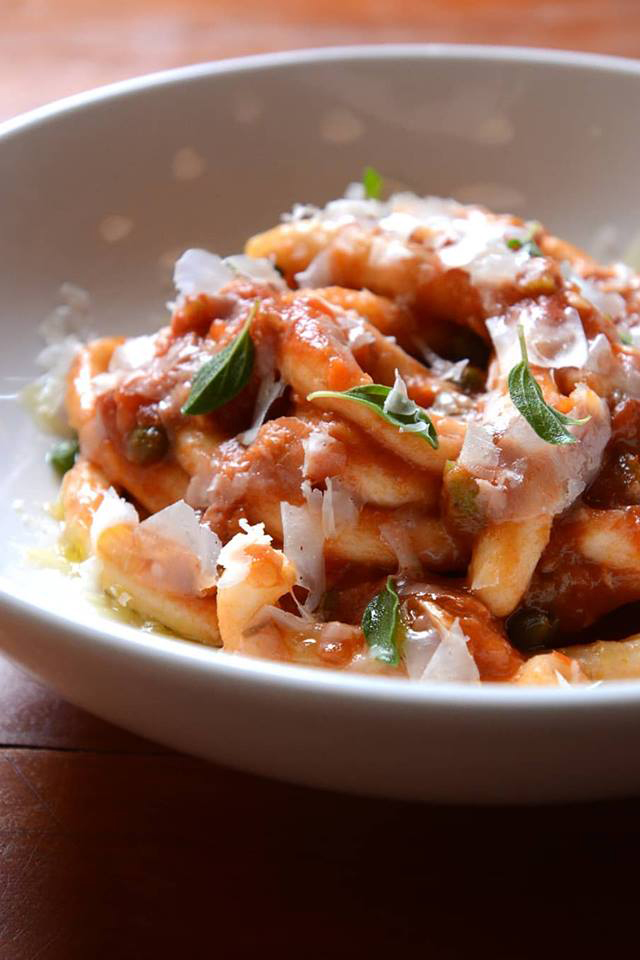Louisville has a lot of things going for it — it’s why it was one of our choices for The Manual Awards 2018, after all. There’s bourbon, of course. And there’s more bourbon. And the beautiful distilleries that make the bourbon.
But there’s even more than that. As the cultural and artistic scene is growing, as is the culinary scene. According to Adam Turla and Sarah Balliet, founding members of the Louisville-based rock band Murder By Death, there was one thing missing from that growing culinary scene: true Neapolitan-style pizza. And thus, Pizza Lupo was born.

“It’s always been something that we’ve talked about because we are very into eating,” Turla says. Having spent 20 years on the road, traveling all over the world in support of their band’s now eight studio albums and five EPs, Turla and Balleit were exposed to tons of food (literally eating every meal out for weeks or months at a time), furthering their wish to make a restaurant a reality. The duo tapped Balliet’s brother, Max (a veteran of Italian fine dining in Louisville and owner of the Holy Molé Taco Truck), to be co-owner and head chef.
“We have things that we’re passionate about that we wanted to bring to Louisville. That’s also a challenge — bringing something to people that they’ve not had before,” Turla says.
While other places in the city have made brick oven pizzas before, they weren’t true Neapolitan style. One of the goals, Turla says, is to push back against the misinformation about what Neapolitan pizza actually is by offering up delicious pizzas done in the true style of his Italian ancestors, using an oven they imported from Modena, Italy.

Originally, Balliet says, they contemplated doing Roman-style pizza, but since no one in the U.S. was doing Roman pizza at all, they saw the idea as being a little too ahead of the curve.
“We thought we might try it, but since no one in Louisville was even doing Neapolitan, we realized are we going to try to have them skip from something they already don’t know to something no one really knows about?” Balliet elaborates.
Once they found a spot — which happened to be a pre-Civil War building in the Butchertown area of Louisville that needed to be completely restored — it took roughly a year to open Pizza Lupo. This, of course, was complicated slightly by the fact that simultaneously they still had a band.
“I had no personal life for about a year in a half,” Turla says. Whether it was being physically in the space to make renovations or coordinating things from the road, it was a huge workload. Thankfully, Turla says, they were able to craft their tour schedule to be beneficial to this process. Only playing choice gigs and events that they normally participate in allowed them to focus on getting the restaurant up and running.
Once Pizza Lupo opened, it was met with almost instant acclaim, including winning Louisville Magazine’s “Best New Restaurant 2018.”
“Pizza is just bread with toppings … If you can refine your dough and make it so it’s a strong feature of your pizza, then it’s going to be a really good pizza.”
To receive such an achievement, a restaurant (obviously) needs to rely on its food, and in this case, Pizza Lupo relies on one key ingredient: its pizza crust.
“Pizza is just bread with toppings,” Turla says. “If you can refine your dough and make it so it’s a strong feature of your pizza, then it’s going to be a really good pizza. It doesn’t matter what you put on it, as long as you’re using good ingredients.”
To make their dough, they start with four ingredients — including the Kentucky water that bourbon is so famous for using — and allow the dough to ferment for between one and two days, before putting it in the oven.
And those “good ingredients?” Turla is talking about both the traditional Italian pizza toppings you can think of, as well as some locally-sourced items to give menu items a Kentucky flair.
Beyond pizza, the restaurant also makes its own pasta by hand, eschewing extractors. The fresh pasta then goes into a variety of seasonal dishes that take advantage of the produce and other ingredients available locally. Their gnudi, for example, features not only the herbed ricotta dumplings, but also spicy braised Stone Cross Farms brisket, kimchi, and garlic. The dish is finished in the wood-burning oven.
To round out the food, Pizza Lupo also has a bar program that is, in true Italian fashion, amaro-heavy.
“There are so many places in Louisville you can go for just bourbon. If you want bourbon tourism, any bar will take care of you,” Turla says. Instead, they wanted a program that would mesh with the foods while still offering a bridge to the bourbon culture that surrounds them.
Classics like the Boulevardier and the Negroni are available, as are house creations such as Bloody Harvest (bourbon, meletti, apple cider, lemon, topped with Lambrusco) and the Sfumato Sour (sfumato, dry curacao, rye, lemon).
They had us at pizza, but then they also had us as pasta and amaro, too. We know where we’re headed the next time we’re in Louisville.








